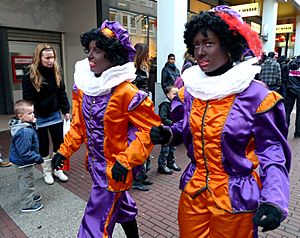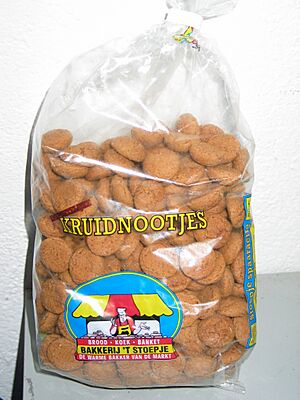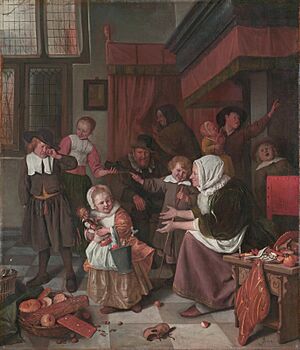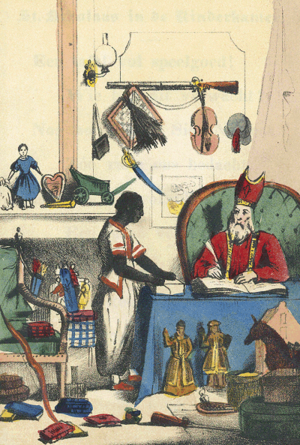Sinterklaas facts for kids
Quick facts for kids
Sinterklaas
|
|
|---|---|
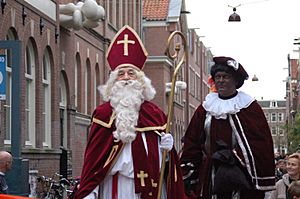
Sinterklaas and his companion Zwarte Piet
|
|
| Known for | Delivering gifts to children on St Nicholas' Eve |
Sinterklaas or Sint-Nicolaas is a beloved legendary figure. He is based on Saint Nicholas, who is known as the patron saint of children. People in the Netherlands and Belgium also call him De Sint ("The Saint") or De Goede Sint ("The Good Saint").
The Sinterklaas celebration happens around 6 December, which is Saint Nicholas Day. Gifts are given on the evening of 5 December in the Netherlands. In Belgium and other nearby countries, gifts are given on the morning of 6 December. This tradition is also celebrated in some places that used to be Dutch colonies, like Aruba.
Sinterklaas is actually one of the inspirations for the famous Christmas character, Santa Claus.
Contents
Who is Sinterklaas?

Sinterklaas is inspired by a real person, Saint Nicholas. He was a Greek bishop who lived a very long time ago (from 270 to 343 AD) in a place now called Turkey.
Sinterklaas looks like an old, wise man. He has white hair and a long, full white beard. He wears a long red cape over a white robe, just like a bishop. He also wears a tall red hat called a mitre and a shiny ruby ring. In his hand, he carries a gold shepherd's staff, which has a fancy curled top.
He traditionally rides a white horse. In the Netherlands, his last horse was named Amerigo. Now, he has a new horse called Ozosnel, which means "oh so fast". In Belgium, his horse is sometimes called Slecht weer vandaag ("bad weather today") or Mooi weer vandaag ("nice weather today").
Sinterklaas carries a big, red book. In this book, he keeps track of whether each child has been good or naughty during the year.
Meet Zwarte Piet, Sinterklaas's Helper
Sinterklaas has helpers called Zwarte Piet ("Black Pete"). Zwarte Piet first appeared in a book in 1850. His colorful clothes look like what nobles wore in the 16th century, with a fancy ruff (a lace collar) and a feathered cap. He usually carries a bag full of candy to toss to children.
In older stories, Zwarte Piet sometimes carried a birch rod. This was a small broom made of willow branches. It was used to gently tap children who had been naughty. Some old songs even said naughty children might be put in Zwarte Piet's bag and taken back to Spain. This part of the story reminds us of old times when people were sometimes taken away. However, in modern Sinterklaas celebrations, Zwarte Piet no longer carries the rod. Children are also not told they will be taken to Spain.
Over the years, Zwarte Piet has become a very helpful assistant to Sinterklaas. Sinterklaas is sometimes a bit forgetful! In TV shows, there are many different Zwarte Pieten. For example, there's a Head Piet, a Navigation Piet to guide the steamboat, and a Presents Piet to wrap gifts. There's even an Acrobatic Piet who can climb roofs and chimneys.
Traditionally, Zwarte Piet's face was said to be black because he was a Moor from Spain. Today, many children are told that his face is black from soot. This is because he climbs through chimneys to deliver gifts for Sinterklaas.
Since the 2010s, there have been discussions about Zwarte Piet's appearance. In many cities and on TV, Zwarte Piet characters now have only some soot smudges on their faces. These are called roetveegpieten ("soot-smudge Petes") or schoorsteenpieten ("chimney Petes"). This change helps make sure everyone feels comfortable and included in the celebration.
How is Sinterklaas Celebrated?
Sinterklaas Arrives from Spain
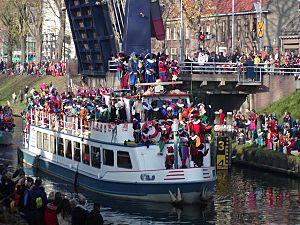
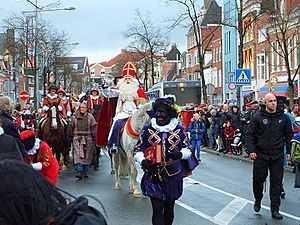
The Sinterklaas festivities usually start in mid-November. This is when Sinterklaas "arrives" by steamboat. He is said to come from Alicante, a city in Spain. In the Netherlands, he arrives at a different port city each year. In Belgium, he always arrives in Antwerp.
When the steamboat docks, Sinterklaas gets off and rides his horse through the streets. Children cheer and sing traditional Sinterklaas songs to welcome him. His Zwarte Piet helpers throw candy and small, round, gingerbread-like cookies. These are called kruidnoten or pepernoten. This exciting event is shown live on national television in both the Netherlands and Belgium.
After the main national arrival, other towns have their own "arrival of Sinterklaas" parades. If a boat cannot reach a town, Sinterklaas might arrive by train, horse, or even a fire truck!
Sinterklaas is said to come from Spain for a few reasons. One reason is that in 1087, some of Saint Nicholas's relics (special items) were moved to Bari, Italy. This city later became part of the Spanish Kingdom of Naples. Another idea is that mandarin oranges, which are traditional gifts from Sinterklaas, made people think he came from Spain. Spain is famous for its oranges.
The Weeks Before Saint Nicholas' Eve
In the weeks between his arrival and 5 December, Sinterklaas visits many places. He goes to schools, hospitals, and shopping centers. People say he rides his white-grey horse over the rooftops at night. He delivers gifts to well-behaved children by dropping them down the chimney.
Before going to bed, children leave a single shoe next to the fireplace or a radiator. They put a carrot or some hay in the shoe for Sinterklaas's horse. They also leave a bowl of water nearby. Then, they sing a Sinterklaas song. The next morning, they find candy or a small present in their shoe!
Some popular Sinterklaas treats include mandarin oranges and pepernoten. There are also speculaas cookies, which sometimes have almond paste inside. Other treats are banketletter (pastry with almond paste) or a chocolate letter (a chocolate shape of the child's first initial). Children also enjoy chocolate coins, sugary animal figures called suikerbeest, and marzipan figures.

Saint Nicholas' Eve and Day
In the Netherlands, 5 December is called Sinterklaasavond ("Sinterklaas evening") or Pakjesavond ("gifts evening"). This is the main night for giving gifts during the winter holidays.
On the evening of 5 December, adults pretend to be Sinterklaas or his helpers. They trick the children into thinking Sinterklaas has really brought them presents. Sometimes, a note is "found" that explains where the gifts are hidden. It might say Zwarte Piet visited and left a sack of presents. A neighbor might even knock on the door, pretending to be a Zwarte Piet, and leave the sack outside. When the presents arrive, the living room is filled with them, much like on Christmas Day. On 6 December, Sinterklaas quietly leaves, and the celebrations are over.
In Belgium, most children wait until the morning of 6 December to get their gifts. Sinterklaas is mostly a celebration for children there. On the evening of the fifth, children fill their shoes with a poem or wish list for Sinterklaas. They also put carrots, hay, or sugar cubes for the horse. In Belgium, they often add a bottle of beer for Zwarte Piet and a cup of coffee for Sinterklaas.
Gifts are often wrapped in a funny or unusual way. This is called a surprise. Poems from Sinterklaas usually come with the gifts. These poems have a personal message for the person receiving the gift. They are often humorous and might gently tease the person about their habits.
Sometimes, as children get older and learn the "big secret of Sinterklaas," families might start giving presents on Christmas Eve or Christmas Day instead. This is influenced by North American traditions. Older children in Dutch families often celebrate Christmas with presents instead of pakjesavond. Family members might draw names for a gift exchange, similar to Secret Santa. Because Sinterklaas is so popular, Santa Claus is not as commonly seen in the Netherlands and Belgium.
The History of Sinterklaas
Ancient Roots of the Celebration
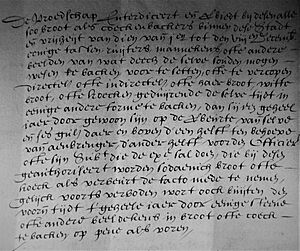
Historians believe that some parts of the Sinterklaas tradition might come from very old, pre-Christian celebrations. It seems clear that some elements of the feast are not from church traditions.
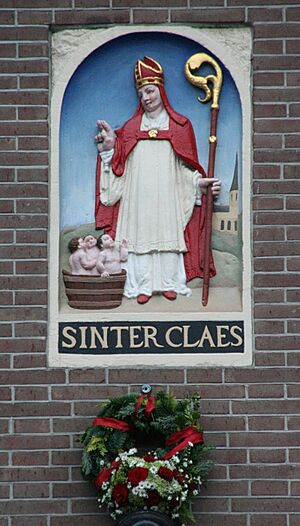
Sinterklaas in the Middle Ages
The Sinterklaasfeest (Sinterklaas feast) began during the Middle Ages. It was a time to help poor people by putting money in their shoes. This later changed into putting presents in children's shoes. It was also a lively celebration, similar to a Carnival.
In early traditions, students would choose one of their classmates to be "bishop" on St. Nicholas Day. This "bishop" would rule until 28 December. They would sometimes act out stories from the bishop's life. As the festival moved to city streets, it became even more fun.
Changes in the 16th and 17th Centuries
During the Protestant Reformation in the 16th and 17th centuries, some Protestant leaders wanted to change how gifts were given. They moved the gift-giving date from 6 December to Christmas Eve. They also wanted to stop celebrating saints.
After the Dutch provinces won their freedom from the Catholic king of Spain, the new Protestant government tried to ban public Catholic celebrations, including Saint Nicholas. However, the Sinterklaas feast never completely disappeared in the Netherlands. In Amsterdam, where the celebrations were very popular, street markets and fairs continued. People dressed as Nicholas in red clothes instead of bishop's robes. The Dutch government eventually allowed private family celebrations of Saint Nicholas' Day. You can see this in Jan Steen's famous painting, The Feast of Saint Nicholas.
Sinterklaas in the 19th Century
In the 19th century, Sinterklaas became more open and less religious. The modern tradition of Sinterklaas as a children's feast was likely shaped by a children's book. This book, Sint-Nicolaas en zijn knecht ('Saint Nicholas and his servant'), was written in 1850 by a teacher named Jan Schenkman.
Schenkman is said to have introduced new ideas. These include Sinterklaas delivering presents through the chimney and riding over rooftops on a grey horse. He also showed Sinterklaas arriving from Spain by steamboat, which was a new and exciting invention back then. Schenkman also wrote the popular song Zie ginds komt de stoomboot ("Look over yonder, the steamboat is arriving").
In Schenkman's book, the medieval figures of helpers were shown for the first time as black African. They were called Zwarte Piet (Black Pete).
Sinterklaas During World War II
During the German occupation of the Netherlands (1940–1945), many traditional Sinterklaas rhymes were changed. They were rewritten to talk about what was happening at the time. The Royal Air Force (RAF) was often praised. For example, in 1941, the RAF dropped boxes of candy over the Netherlands.
Here's an example of a traditional poem changed for the war:
Sinterklaas, kapoentje,
Sinterklaas, little rascal, |
R.A.F. Kapoentje,
R.A.F. little rascal, |
This poem replaced "Sinterklaas" with "RAF." It encouraged the RAF to drop bombs on the Germans (called Moffen) but scatter candy over the Netherlands. Many poems from this time talked about the lack of food and how the Germans had taken valuable things. Others showed admiration for the Dutch Resistance.
Originally, Sinterklaas had only one or two Zwarte Pieten. But after the Netherlands was freed, Canadian soldiers organized a Sinterklaas party with many Zwarte Pieten. Since then, it has been the custom to have many Pieten, each with their own special job.
Sinterklaas Around the World
Sinterklaas in Former Dutch Colonies
In Curaçao, Sinterklaas events were held in the Dutch style until 2020. The Zwarte Piet costumes were colorful, but especially black. In 2011, the government even thought about stopping funding for the Dutch tradition. This happened after an activist protested against Zwarte Piet. Since 2020, Sinterklaas is no longer a national celebration in Curaçao. It has been replaced by Children's Day on 20 November.
Dutch-style Sinterklaas events also took place in Suriname. In 1970, a Surinamese writer created a character called Gudu Ppa ("Father of Riches"). He was meant to replace Sinterklaas. Gudu Ppa was black, and his helpers represented Suriname's different ethnic groups. Even though the government promoted him in the 1980s, Gudu Ppa never became very popular. In 2011, a former president asked for an official ban on Sinterklaas. He thought Zwarte Piet was a racist element. Since 2013, Sinterklaas on 5 December has been replaced by Kinderdag ("Children's Day") in Suriname.
The Saint Nicholas Society of New York still celebrates a feast on 6 December. In the Hudson Valley region of New York, towns like Rhinebeck and Kingston celebrate Sinterklaas every year. This is because of the region's Dutch history. The celebration includes Sinterklaas crossing the Hudson River and then a parade.
Sinterklaas and Santa Claus
Sinterklaas is the main inspiration for the North American character of Santa Claus. It is often said that during the American Revolutionary War, people in New York City (which used to be a Dutch town called New Amsterdam) brought back their Sinterklaas tradition. Saint Nicholas was a symbol of the city's non-English past.
In 1812, a writer named Washington Irving wrote stories that included legends of the early Dutch settlers. He described St. Nicholas flying over treetops in a wagon. This idea later helped shape Santa Claus.
In New York, in 1810, a man named John Pintard published a pamphlet. He wanted to make Saint Nicholas the patron saint of New York and start a Sinterklaas tradition. He included an old Dutch Sinterklaas poem with an English translation. In the Dutch poem, Saint Nicholas is called 'Sancta Claus'. This helped Sinterklaas become Santa Claus in Christmas celebrations.
During the Protestant Reformation in Europe, many Protestants changed the gift-giver from Sinterklaas to the Christ Child. The date for giving gifts also changed from 5 or 6 December to Christmas Eve.
Sinterklaas in Movies and TV
Sinterklaas has appeared in many movies and TV shows.
In the 1947 film Miracle on 34th Street, a Dutch girl recognizes the Macy's department store Santa as Sinterklaas. They talk in Dutch and sing a Sinterklaas song together.
In the 1985 film One Magic Christmas, Santa Claus is shown as Sinterklaas. He and his wife have Dutch accents, and she calls him Nicolaas. Instead of elves, his helpers are "Christmas angels" who are people who have passed away.
Many Dutch novels, films, and TV series are about Sinterklaas, mostly for children. Children's films include Winky's Horse (2005) and its sequel Where Is Winky's Horse? (2007).
Films for adults include the drama Makkers Staakt uw Wild Geraas (1960). There's also the romantic comedy Alles is Liefde (2007) and the Dick Maas-directed horror film Sint (2010).
De Club van Sinterklaas is a Sinterklaas-themed TV show for children. It has been running since 1999. Since 2001, a Sinterklaas "news" program for children, the Sinterklaasjournaal, is broadcast daily during the holiday season. The Dutch-Belgian Nickelodeon series Slot Marsepeinstein has aired since 2009.
Sinterklaas also appeared in Sesamstraat, the Dutch version of Sesame Street.
Other Holiday Figures Like Sinterklaas
Many other holiday figures are based on Saint Nicholas. They are celebrated in different parts of Europe:
- Germany and Austria: Sankt Nikolaus
- Czech Republic: Mikuláš
- Hungary: Mikulás
- Switzerland: Samichlaus
- Italy: San Nicola
- Croatia and Serbia: Sveti Nikola
- Slovenia: Sveti Nikolaj or Sveti Miklavž
- Greece: Agios Nikolaos
- Romania: Moș Nicolae
- Albania: Shën Kolli or Nikolli
These are just a few examples of how Saint Nicholas is celebrated around the world.


